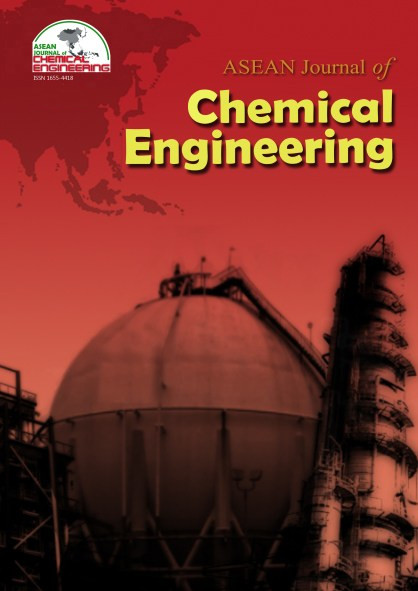Experimental Study on Hydrocracking Process of Asbuton Hydrocarbon Based on the Aromatic, and Waxy Residue Based on Paraffinic, by using Pt/Pd and γ-Alumina Catalyst in a Fixed Bed Reactor
Abstract
The studies on the hydrocracking process to obtain the fuel by cracking of the
carbon chain from the hydrocarbon compound both in the form of gas and liquid fuels
have been carried-out massively by researchers over three decade. In the present
experimental study, heavy hydrocarbon represented by asphaltic base materials (named
as Extracted Asbuton) and paraffinic (waxy residue from Cepu oil refinery) were used as
the object of the study; by observing the differences of the reaction mechanisms and
the results that can be obtained. Here the operational conditions such as pressure,
temperature, and time as well as the kinds of catalyst were considered as the main
parameters.
The experiments were carried-out under the similar operating condition such as
temperature around 350 – 500oC, pressure around 5 up to 15 atmospheres, and
evaporation time was (1 – 3) hours. As a result, it was obtained (a) the higher the
temperature, pressure, and heating time, the higher hydrocracking conversion both of
hydrocarbons, (b) reaction mechanism of hydrocracking by using asphalt extract as the
material follows the Model 3 of the present work, in which asphalt vapor was trapped in
catalyst surface, meanwhile the waxy residue followed the Model 1, (c) under the same
condition, the conversion of asphalt extract was smaller than waxy residue, and (d) the
conversion of asphalt extract using Pt/Pd catalyst was higher than γ-Alumina catalyst.
References
pp. 33-45.
2. Abraham, Herbert, (2007), Asphalt and Allied substances their of occurence, modus of production uses in the arts and methodes of testing, page 291
3. Affandy, I. H., (2006), Hydrocracking Aspal Buton Dengan Katalis Pt / Pd 2:1 Dalam Zeolite Menjadi Bahan Bakar Minyak, Bachelor thesin, Universitas Gadjah Mada, Yogyakarta (In: Bahasa Indonesia)
4. Balci,S., Dogu, T., and Yucel, H.,(1993), Pyrolysis Kinetics of Lignocellulosic Material, Ind.Eng. Chem. Res., 32, pp. 2573-2579
5. Campbell, I .A., (1988), Katalyst and surfaces, Champman and Hall Ltd., London
6. De Pauw, 1975, Modeling and Optimation of Chatalitic Reforming process and Most Refinaries it is Used for Hydrocracking and Hydrotryting, Dissertation of Texas Tech University.
7. Fogler, H.S., (2005), Elements of Chemical Reaction Engineering, 4th Edition, pp. 241-310, , Prentice-Hall International, Inc., New Jersey.
8. Hatch, L.F.,and Matars, S., (2000), From Hydrocarbons to Petrochemicals” second edition, pp. 24-40, Gulf Publishing Company, Houston.
9. Shui, H., Chen, Z., Wan, Z., Zhang, D., 2010. Kinetics of Shenhua coal liquefaction catalyzed by SO4/ZrO2solid acid, FUEL, Vol. 89, issue 1, pp. 67-72. In Univesity of Northumbria at Newcastle.
10. Jones, D.S.J., (1995), Elements of Petroleum Processing, pp. 275-278, John Willey & Sons, New York.
11. Bhutani , N., Ray, A.K., and Angaiah, G.P. (2006), Modeling, Simulation, and Multi-objective Optimization of an Industrial Hydrocracking Unit, Ind. Eng. Chem. Res., Vol. 45 (4), pp 1354–1372 .
12. Sarifudin, K., (2004), PengaruhRasio Ni/Mo dan Kandungan Nb2O5 terhadap Karakter, Aktivitas dan Selektivitas Katalis Ni-Mo/Nb2O5--Al2O3 dan Modifikasinya untuk Proses
Perengkahan Fraksi Aspalten dari Aspal Buton”, Master Tesis, Program Pasca Sarjana UGM, Yogyakarta (In: Bahasa Indonesia).
13. Speight, J.G., (2014), The Chemistry and Technology of Petroleum, vol 3, Fifth edition, pp 189-315, CRC Press.
14. Suryo P. and Murachman B., (2012), Teknologi Minyak Bumi, pp.146-150, Pasca Sarjana Universitas Gadjah Mada , Yogyakarta (In: Bahasa Indonesia).
15. Widayati, A., 2003, Rattan Cane Harvesting in Lambusango Forest, Buton, Indonesia : A Sustainable Practice or a Threat to Forest Conversation, Disertation
Copyright holder for articles is ASEAN Journal of Chemical Engineering. Articles published in ASEAN J. Chem. Eng. are distributed under a Creative Commons Attribution-NonCommercial 4.0 International (CC BY-NC 4.0) license.
Authors agree to transfer all copyright rights in and to the above work to the ASEAN Journal of Chemical Engineering Editorial Board so that the Editorial Board shall have the right to publish the work for non-profit use in any media or form. In return, authors retain: (1) all proprietary rights other than copyright; (2) re-use of all or part of the above paper in their other work; (3) right to reproduce or authorize others to reproduce the above paper for authors’ personal use or for company use if the source and the journal copyright notice is indicated, and if the reproduction is not made for the purpose of sale.



